Learning Subject-Generalized Topographical EEG Embeddings Using Deep Variational Autoencoders and Domain-Adversarial Regularization
Abstract
1. Introduction
1.1. Machine Learning with EEG
1.2. Topographic Models
1.3. Subject-Invariant Feature Extraction
2. Literature Review
2.1. Domain Adaptation
2.1.1. Kernel-Based Methods
2.1.2. Deep Learning Methods
2.2. Domain Generalization
2.2.1. Domain Agnostic Methods
2.2.2. Deep Latent Variable Methods
2.2.3. Multi-Domain Adaptation
2.3. Contributions of the Work
3. Methodology
3.1. Input Data
3.2. Deep Learning Architecture
3.3. Regularizing for Normally Distributed Features
Variational Autoencoders
3.4. Optimizing for Subject-Independence
Domain Adversarial Neural Networks
| Algorithm 1: Bi-lateral VAE Pre-training |
 |
3.5. Training Phases
3.5.1. Unsupervised VAE Pretraining
3.5.2. Supervised EEG-BiVDANN Training
| Algorithm 2: Bi-lateral VAE Pretraining |
 |
3.5.3. EEG-BiVDANN Model Objective
3.6. Datasets
3.7. Data Preparation
3.8. Model Implementation
4. Experiments and Results
4.1. Training Hyperparameters
4.2. Comparison Results
- CNN—simple 2D CNN featuring 3 × [Conv2D(3 × 3) + BatchNorm] layers with ∼200,000 trainable parameters
- Resnet-50 [60]—popular DL network for image classification with ∼23 million trainable parameters
- KPCA [61]—nonlinear dimensionality reduction technique
- MIDA [25]—semi-supervised domain adaptation technique for mapping data to domain-invariant subspace
4.3. Qualitative Analysis of Embeddings
4.3.1. SEED Embeddings
4.3.2. DEAP Embeddings
4.3.3. General Observations
4.4. Model Ablation Study
- BiCNN—includes bilateral inputs, but no variational regularization or domain- independent regularization.
- BiVAE—includes bilateral inputs, includes variational regularization, but no domain-independent regularization.
- BiDANN—includes bilateral inputs, includes domain-independent regularization, but no variational regularization.
- L-VDANN—only left-hemisphere inputs, includes both variational regularization and domain-independent regularization.
- R-VDANN—only right-hemisphere inputs, includes both variational regularization and domain-independent regularization.
5. Discussion
6. Conclusions
Author Contributions
Funding
Institutional Review Board Statement
Informed Consent Statement
Data Availability Statement
Conflicts of Interest
References
- Beale, R.; Peter, C. The role of affect and emotion in HCI. In Affect and Emotion in Human-Computer Interaction; Springer: Berlin/Heidelberg, Germany, 2008; pp. 1–11. [Google Scholar]
- Torres P, E.P.; Torres, E.A.; Hernández-Álvarez, M.; Yoo, S.G. EEG-Based BCI Emotion Recognition: A Survey. Sensors 2020, 20, 5083. [Google Scholar] [CrossRef]
- Soleymani, M.; Asghari-Esfeden, S.; Fu, Y.; Pantic, M. Analysis of EEG signals and facial expressions for continuous emotion detection. IEEE Trans. Affect. Comput. 2015, 7, 17–28. [Google Scholar] [CrossRef]
- Kachenoura, A.; Albera, L.; Senhadji, L.; Comon, P. ICA: A potential tool for BCI systems. IEEE Signal Process. Mag. 2007, 25, 57–68. [Google Scholar] [CrossRef]
- Chang, C.Y.; Hsu, S.H.; Pion-Tonachini, L.; Jung, T.P. Evaluation of artifact subspace reconstruction for automatic EEG artifact removal. In Proceedings of the 2018 40th Annual International Conference of the IEEE Engineering in Medicine and Biology Society (EMBC), Honolulu, HI, USA, 18–21 July 2018; pp. 1242–1245. [Google Scholar]
- Lakshmi, M.R.; Prasad, T.; Prakash, D.V.C. Survey on EEG signal processing methods. Int. J. Adv. Res. Comput. Sci. Softw. Eng. 2014, 4, 84–91. [Google Scholar]
- Roy, Y.; Banville, H.; Albuquerque, I.; Gramfort, A.; Falk, T.H.; Faubert, J. Deep learning-based electroencephalography analysis: A systematic review. J. Neural Eng. 2019, 16, 051001. [Google Scholar] [CrossRef]
- Schirrmeister, R.T.; Springenberg, J.T.; Fiederer, L.D.J.; Glasstetter, M.; Eggensperger, K.; Tangermann, M.; Hutter, F.; Burgard, W.; Ball, T. Deep learning with convolutional neural networks for EEG decoding and visualization. Hum. Brain Mapp. 2017, 38, 5391–5420. [Google Scholar] [CrossRef]
- Ang, K.K.; Chin, Z.Y.; Zhang, H.; Guan, C. Filter bank common spatial pattern (FBCSP) in brain–computer interface. In Proceedings of the 2008 IEEE International Joint Conference on Neural Networks (IEEE World Congress on Computational Intelligence), Hong Kong, China, 1–8 June 2008; pp. 2390–2397. [Google Scholar]
- Lawhern, V.J.; Solon, A.J.; Waytowich, N.R.; Gordon, S.M.; Hung, C.P.; Lance, B.J. EEGNet: A compact convolutional neural network for EEG-based brain–computer interfaces. J. Neural Eng. 2018, 15, 056013. [Google Scholar] [CrossRef] [PubMed]
- Lotte, F.; Bougrain, L.; Cichocki, A.; Clerc, M.; Congedo, M.; Rakotomamonjy, A.; Yger, F. A review of classification algorithms for EEG-based brain–computer interfaces: A 10 year update. J. Neural Eng. 2018, 15, 031005. [Google Scholar] [CrossRef] [PubMed]
- Hagad, J.L.; Fukui, K.; Numao, M. Deep visual models for EEG of mindfulness meditation in a workplace setting. In Precision Health and Medicine; Springer Nature: Cham, Switzerland, 2019; pp. 129–137. [Google Scholar]
- Bashivan, P.; Rish, I.; Yeasin, M.; Codella, N. Learning representations from EEG with deep recurrent-convolutional neural networks. arXiv 2015, arXiv:1511.06448. [Google Scholar]
- Li, Y.; Zheng, W.; Zong, Y.; Cui, Z.; Zhang, T.; Zhou, X. A bi-hemisphere domain adversarial neural network model for EEG emotion recognition. IEEE Trans. Affect. Comput. 2018. [Google Scholar] [CrossRef]
- Duan, R.N.; Zhu, J.Y.; Lu, B.L. Differential entropy feature for EEG-based emotion classification. In Proceedings of the 2013 6th International IEEE/EMBS Conference on Neural Engineering (NER), San Diego, CA, USA, 6–8 November 2013; pp. 81–84. [Google Scholar]
- Zheng, W.L.; Lu, B.L. Investigating critical frequency bands and channels for EEG-based emotion recognition with deep neural networks. IEEE Trans. Auton. Ment. Dev. 2015, 7, 162–175. [Google Scholar] [CrossRef]
- Li, Y.; Wang, L.; Zheng, W.; Zong, Y.; Qi, L.; Cui, Z.; Zhang, T.; Song, T. A novel bi-hemispheric discrepancy model for eeg emotion recognition. IEEE Trans. Cogn. Dev. Syst. 2020. [Google Scholar] [CrossRef]
- Ghifary, M. Domain Adaptation and Domain Generalization with Representation Learning. Ph.D. Thesis, Victoria University of Wellington, Kelburn, New Zealand, 15 July 2016. [Google Scholar]
- Wilson, G.; Cook, D.J. A Survey of Unsupervised Deep Domain Adaptation. ACM Trans. Intell. Syst. Technol. 2020, 11, 1–46. [Google Scholar] [CrossRef]
- Rice, L.; Wong, E.; Kolter, Z. Overfitting in Adversarially Robust Deep Learning. Available online: http://proceedings.mlr.press/v119/rice20a.html (accessed on 4 March 2021).
- Wang, M.; Deng, W. Deep visual domain adaptation: A survey. Neurocomputing 2018, 312, 135–153. [Google Scholar] [CrossRef]
- Lan, Z.; Sourina, O.; Wang, L.; Scherer, R.; Müller-Putz, G.R. Domain adaptation techniques for EEG-based emotion recognition: A comparative study on two public datasets. IEEE Trans. Cogn. Dev. Syst. 2018, 11, 85–94. [Google Scholar] [CrossRef]
- Hofmann, T.; Schölkopf, B.; Smola, A.J. Kernel methods in machine learning. Ann. Stat. 2008, 36, 1171–1220. [Google Scholar] [CrossRef]
- Pan, S.J.; Tsang, I.W.; Kwok, J.T.; Yang, Q. Domain adaptation via transfer component analysis. IEEE Trans. Neural Netw. 2010, 22, 199–210. [Google Scholar] [CrossRef]
- Yan, K.; Kou, L.; Zhang, D. Learning domain-invariant subspace using domain features and independence maximization. IEEE Trans. Cybern. 2017, 48, 288–299. [Google Scholar] [CrossRef]
- Gretton, A.; Bousquet, O.; Smola, A.; Schölkopf, B. Measuring statistical dependence with Hilbert-Schmidt norms. In Proceedings of the International Conference on Algorithmic Learning Theory, Singapore, 8–11 October 2005; pp. 63–77. [Google Scholar]
- Cimtay, Y.; Ekmekcioglu, E. Investigating the use of pretrained convolutional neural network on cross-subject and cross-dataset EEG emotion recognition. Sensors 2020, 20, 2034. [Google Scholar] [CrossRef]
- Luo, Y.; Zhang, S.Y.; Zheng, W.L.; Lu, B.L. WGAN domain adaptation for EEG-based emotion recognition. In Proceedings of the International Conference on Neural Information Processing, Siem Reap, Cambodia, 13–16 December 2018; pp. 275–286. [Google Scholar]
- Phan, A.V.; Le Nguyen, M.; Nguyen, Y.L.H.; Bui, L.T. Dgcnn: A convolutional neural network over large-scale labeled graphs. Neural Netw. 2018, 108, 533–543. [Google Scholar] [CrossRef]
- Li, J.; Qiu, S.; Du, C.; Wang, Y.; He, H. Domain Adaptation for EEG Emotion Recognition Based on Latent Representation Similarity. IEEE Trans. Cogn. Dev. Syst. 2019, 12, 344–353. [Google Scholar] [CrossRef]
- Li, D.; Yang, Y.; Song, Y.Z.; Hospedales, T.M. Deeper, broader and artier domain generalization. In Proceedings of the IEEE International Conference on Computer Vision, Venice, Italy, 22–29 October 2017; pp. 5542–5550. [Google Scholar]
- Schölkopf, B.; Smola, A.; Müller, K.R. Nonlinear component analysis as a kernel eigenvalue problem. Neural Comput. 1998, 10, 1299–1319. [Google Scholar] [CrossRef]
- Pandey, P.; Seeja, K. Subject independent emotion recognition from EEG using VMD and deep learning. J. King Saud-Univ.-Comput. Inf. Sci. 2019, in press. [Google Scholar] [CrossRef]
- Dragomiretskiy, K.; Zosso, D. Variational mode decomposition. IEEE Trans. Signal Process. 2013, 62, 531–544. [Google Scholar] [CrossRef]
- Dai, M.; Zheng, D.; Na, R.; Wang, S.; Zhang, S. EEG classification of motor imagery using a novel deep learning framework. Sensors 2019, 19, 551. [Google Scholar] [CrossRef] [PubMed]
- Chai, X.; Wang, Q.; Zhao, Y.; Liu, X.; Bai, O.; Li, Y. Unsupervised domain adaptation techniques based on auto-encoder for non-stationary EEG-based emotion recognition. Comput. Biol. Med. 2016, 79, 205–214. [Google Scholar] [CrossRef] [PubMed]
- Ganin, Y.; Ustinova, E.; Ajakan, H.; Germain, P.; Larochelle, H.; Laviolette, F.; Marchand, M.; Lempitsky, V. Domain-adversarial training of neural networks. J. Mach. Learn. Res. 2016, 17, 1–35. [Google Scholar]
- Gramfort, A.; Luessi, M.; Larson, E.; Engemann, D.A.; Strohmeier, D.; Brodbeck, C.; Parkkonen, L.; Hämäläinen, M.S. MNE software for processing MEG and EEG data. Neuroimage 2014, 86, 446–460. [Google Scholar] [CrossRef] [PubMed]
- Percival, D.B.; Walden, A.T. Spectral Analysis for Physical Applications; Cambridge University Press: Cambridge, UK, 1993. [Google Scholar]
- Wang, X.W.; Nie, D.; Lu, B.L. Emotional state classification from EEG data using machine learning approach. Neurocomputing 2014, 129, 94–106. [Google Scholar] [CrossRef]
- Zhuang, N.; Zeng, Y.; Tong, L.; Zhang, C.; Zhang, H.; Yan, B. Emotion recognition from EEG signals using multidimensional information in EMD domain. BioMed Res. Int. 2017, 2017. [Google Scholar] [CrossRef]
- Jatupaiboon, N.; Pan-ngum, S.; Israsena, P. Emotion classification using minimal EEG channels and frequency bands. In Proceedings of the 2013 10th International Joint Conference on Computer Science and Software Engineering (JCSSE), Khon Kaen, Thailand, 29–31 May 2013; pp. 21–24. [Google Scholar]
- Wager, T.D.; Phan, K.L.; Liberzon, I.; Taylor, S.F. Valence, gender, and lateralization of functional brain anatomy in emotion: A meta-analysis of findings from neuroimaging. Neuroimage 2003, 19, 513–531. [Google Scholar] [CrossRef]
- Higgins, I.; Matthey, L.; Pal, A.; Burgess, C.; Glorot, X.; Botvinick, M.; Mohamed, S.; Lerchner, A. beta-VAE: Learning Basic Visual Concepts with a Constrained Variational Framework. In Proceedings of the International Conference on Learning Representations, Toulon, France, 24–26 April 2017. [Google Scholar]
- Hou, X.; Shen, L.; Sun, K.; Qiu, G. Deep feature consistent variational autoencoder. In Proceedings of the 2017 IEEE Winter Conference on Applications of Computer Vision (WACV), Santa Rosa, CA, USA, 24–31 March 2017; pp. 1133–1141. [Google Scholar]
- Li, H.; Wang, H.; Yang, Z.; Odagaki, M. Variation autoencoder based network representation learning for classification. In Proceedings of the ACL 2017, Student Research Workshop, Vancouver, BC, Canada, 30 July–4 August 2017; pp. 56–61. [Google Scholar]
- Li, Y.; Pan, Q.; Wang, S.; Peng, H.; Yang, T.; Cambria, E. Disentangled variational auto-encoder for semi-supervised learning. Inf. Sci. 2019, 482, 73–85. [Google Scholar] [CrossRef]
- Aznan, N.K.N.; Atapour-Abarghouei, A.; Bonner, S.; Connolly, J.D.; Al Moubayed, N.; Breckon, T.P. Simulating brain signals: Creating synthetic eeg data via neural-based generative models for improved ssvep classification. In Proceedings of the 2019 International Joint Conference on Neural Networks (IJCNN), Budapest, Hungary, 14–19 July 2019; pp. 1–8. [Google Scholar]
- Kingma, D.P.; Welling, M. Auto-encoding variational bayes. arXiv 2013, arXiv:1312.6114. [Google Scholar]
- Kingma, D.P.; Welling, M. An introduction to variational autoencoders. arXiv 2019, arXiv:1906.02691. [Google Scholar] [CrossRef]
- Burgess, C.P.; Higgins, I.; Pal, A.; Matthey, L.; Watters, N.; Desjardins, G.; Lerchner, A. Understanding disentangling in β-VAE. arXiv 2018, arXiv:1804.03599. [Google Scholar]
- Eduardo, S.; Nazábal, A.; Williams, C.K.; Sutton, C. Robust Variational Autoencoders for Outlier Detection and Repair of Mixed-Type Data. Available online: http://proceedings.mlr.press/v108/eduardo20a.html (accessed on 4 March 2021).
- Tu, Y.; Mak, M.W.; Chien, J.T. Variational Domain Adversarial Learning for Speaker Verification. In Proceedings of the 20th Annual Conference of the International Speech Communication Association, Graz, Austria, 15–19 September 2019; pp. 4315–4319. [Google Scholar]
- Koelstra, S.; Muhl, C.; Soleymani, M.; Lee, J.S.; Yazdani, A.; Ebrahimi, T.; Pun, T.; Nijholt, A.; Patras, I. Deap: A database for emotion analysis; using physiological signals. IEEE Trans. Affect. Comput. 2011, 3, 18–31. [Google Scholar] [CrossRef]
- Candra, H.; Yuwono, M.; Chai, R.; Handojoseno, A.; Elamvazuthi, I.; Nguyen, H.T.; Su, S. Investigation of window size in classification of EEG-emotion signal with wavelet entropy and support vector machine. In Proceedings of the 2015 37th Annual International Conference of the IEEE Engineering in Medicine and Biology Society (EMBC), Milan, Italy, 25–29 August 2015; pp. 7250–7253. [Google Scholar]
- Gramfort, A.; Luessi, M.; Larson, E.; Engemann, D.A.; Strohmeier, D.; Brodbeck, C.; Goj, R.; Jas, M.; Brooks, T.; Parkkonen, L.; et al. MEG and EEG data analysis with MNE-Python. Front. Neurosci. 2013, 7, 267. [Google Scholar] [CrossRef]
- Thomson, D.J. Jackknifing multitaper spectrum estimates. IEEE Signal Process. Mag. 2007, 24, 20–30. [Google Scholar] [CrossRef]
- Chollet, F. Keras: The Python Deep Learning Library, Astrophysics Source Code Library. Available online: https://ui.adsabs.harvard.edu/abs/2018ascl.soft06022C/abstract (accessed on 4 March 2021).
- Kingma, D.P.; Ba, J. Adam: A method for stochastic optimization. arXiv 2014, arXiv:1412.6980. [Google Scholar]
- He, K.; Zhang, X.; Ren, S.; Sun, J. Deep residual learning for image recognition. In Proceedings of the IEEE Conference on Computer Vision and Pattern Recognition, Las Vegas, NV, USA, 27–30 June 2016; pp. 770–778. [Google Scholar]
- Mika, S.; Schölkopf, B.; Smola, A.J.; Müller, K.R.; Scholz, M.; Rätsch, G. Kernel PCA and De-Noising in Feature Spaces. Available online: https://www.academia.edu/download/47985099/kpca-de-noising-feature-space.pdf (accessed on 4 March 2020).
- Maaten, L.V.d.; Hinton, G. Visualizing data using t-SNE. J. Mach. Learn. Res. 2008, 9, 2579–2605. [Google Scholar]
- Borg, I.; Groenen, P.J. Modern Multidimensional Scaling: Theory and Applications; Springer Science & Business Media: Heidelberg, Germany, 2005. [Google Scholar]
- Yosinski, J.; Clune, J.; Nguyen, A.; Fuchs, T.; Lipson, H. Understanding neural networks through deep visualization. arXiv 2015, arXiv:1506.06579. [Google Scholar]

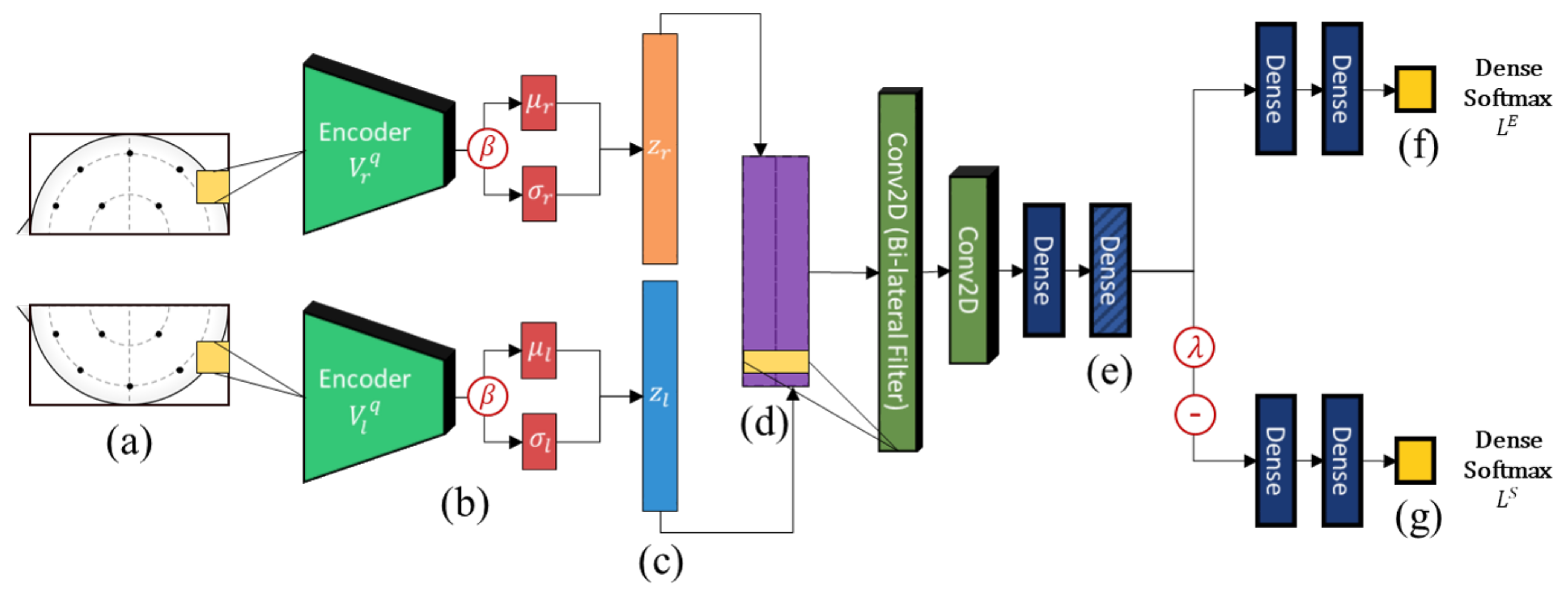

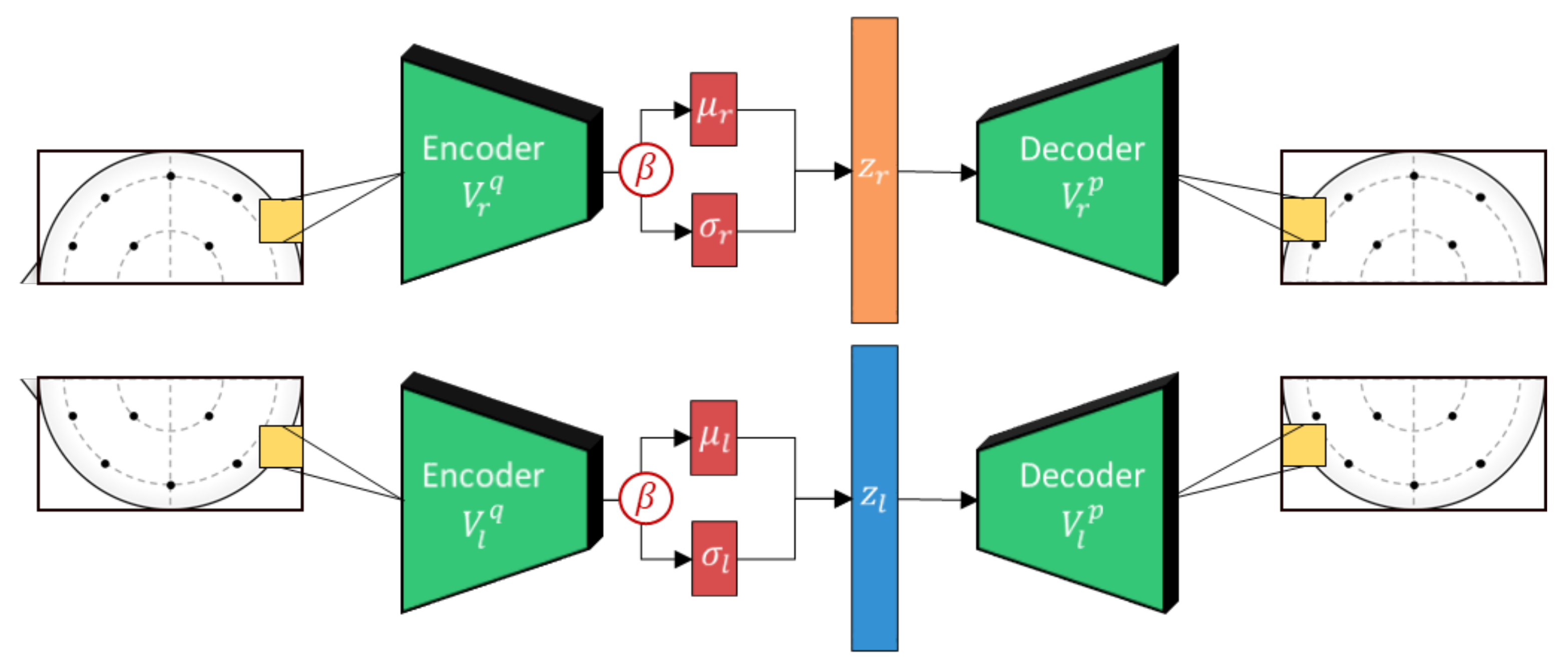
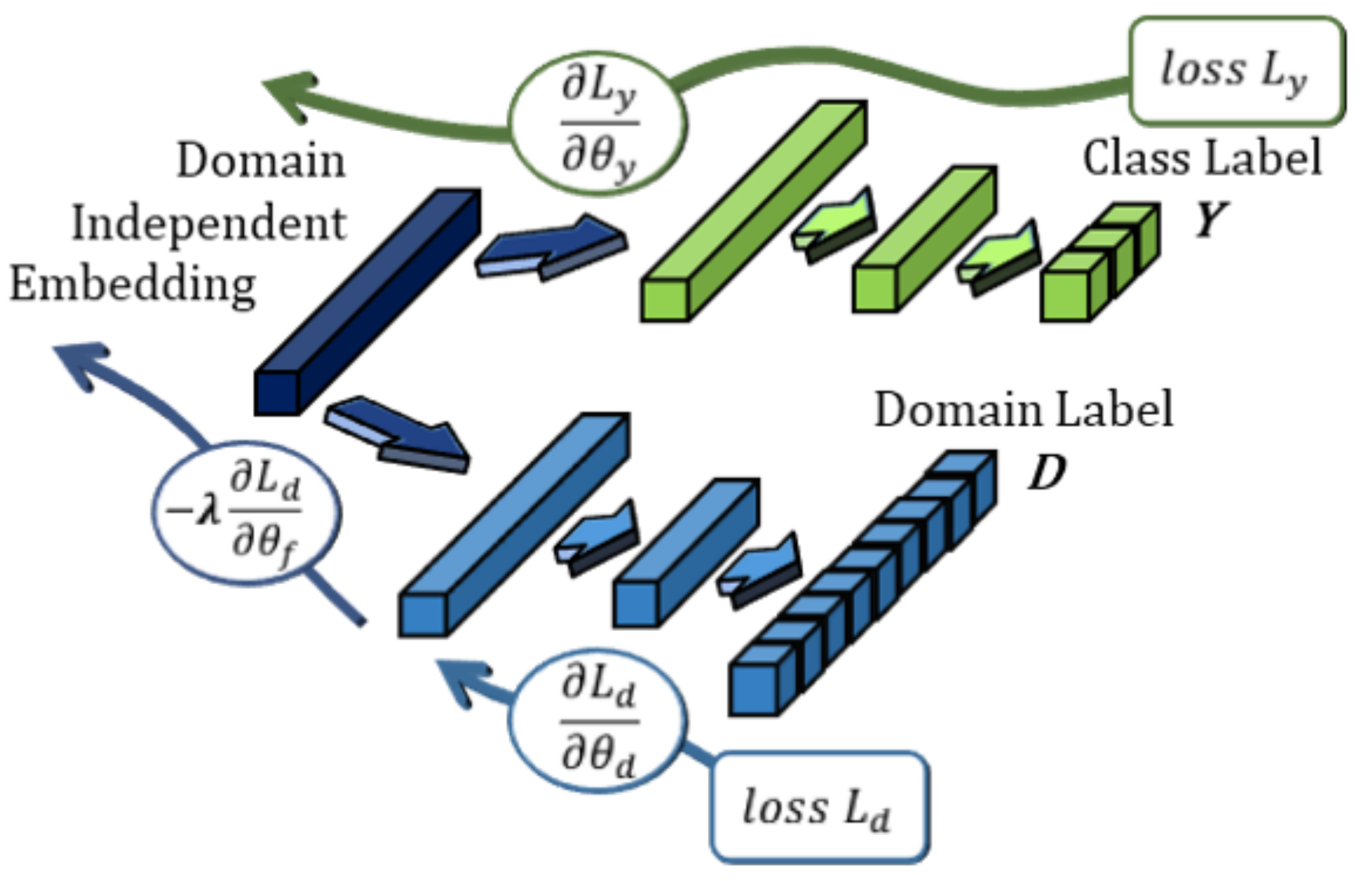
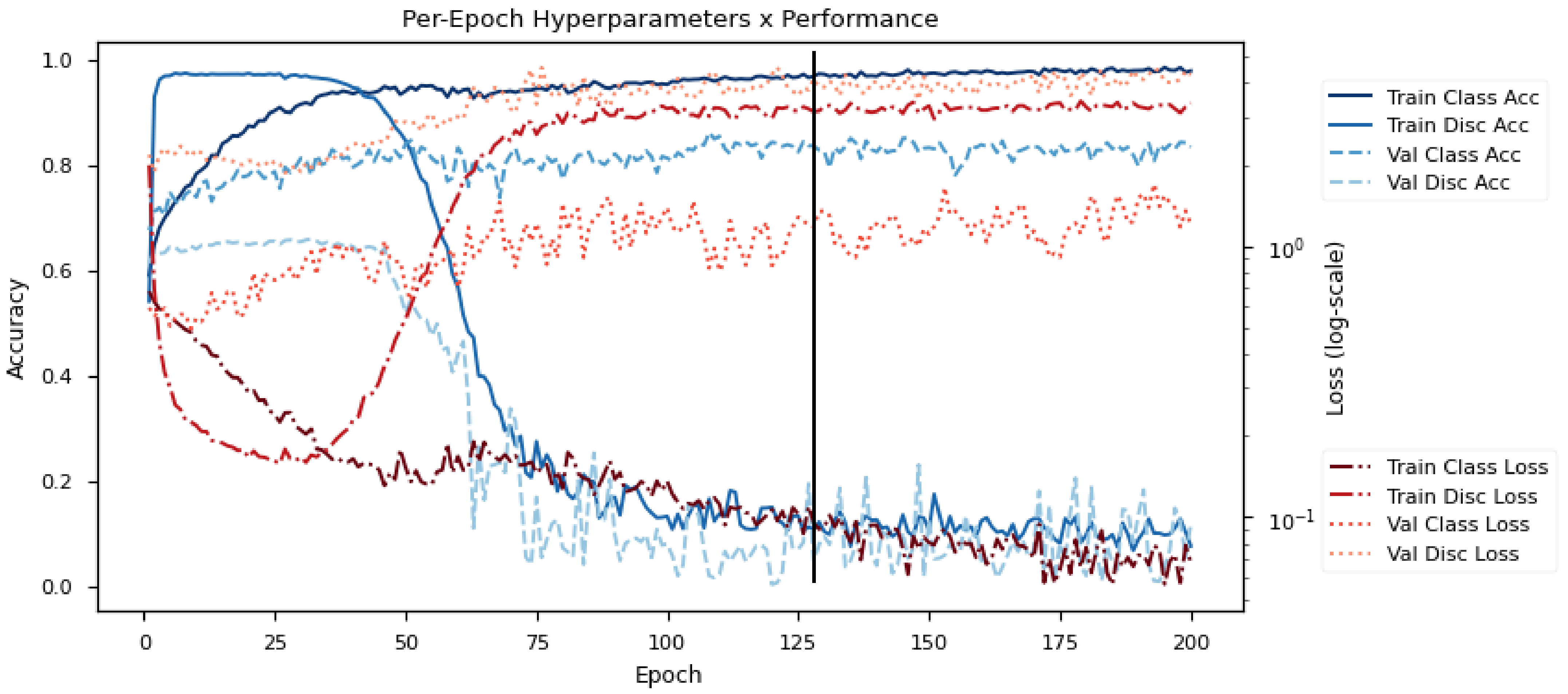
| Method | Algorithm Type | Domain Invariance | Adaptation Type | Distribution |
|---|---|---|---|---|
| TCA [24] | Kernel-based | MMD | Binary domain | Centered distribution |
| MIDA [25] | Kernel-based | HSIC | Multi-domain | Centered distribution |
| WGAN [28] | Deep Learning | Wasserstein distance | Binary domain | None |
| KPCA [32] | Kernel-based | Principal components | None | Centered distribution |
| VMD [33] | Signal Decomposition | IMF decomposition | None | Approx. Gaussian |
| VAE [35] | Deep Learning | None | None | Gaussian |
| SAAE [36] | Deep Learning | MMD | Binary domain | None |
| DANN [37] | Deep Learning | Adversarial training | Multi-domain | None |
| BiDANN [14] | Deep Learning | Adversarial training | Binary domain | None |
| BiVDANN [Ours] | Deep Learning | Adversarial training | Multi-domain | Gaussian |
| Component | Input (Dims) | Components (Dims) | Output (Dims) |
|---|---|---|---|
| Unilateral VAE | Topograph: (32,64) | Encoder: 3 × [Conv2D(3 × 3) + BatchNorm] VAE Embedding: [Dense(512) + Mean: Dense(64) + SD: Dense(64) + z: Dense(64)] Decoder: 3 × [Conv2DTranspose(3 × 3) + BatchNorm] | Unilateral Embedding: (64) |
| Bilateral Feature Extractor | Unilateral Embeddings: 2 × (64) | [Concat + 2 × [Conv2D(2 × 2) + BatchNorm] + 2 × [Dense(128) + BatchNorm]] | Bilateral Embedding: (128) |
| Emotion Classifier | Bilateral Embedding: (128) | 2 × [Dense(256) + BatchNorm] + 1 × [Dense(64) + BatchNorm] + Dense(Softmax) | Emotion prediction: (# of classes) |
| Adversarial Subject Classifier | Bilateral Embedding: (128) | GradientReversal + 2 × [Dense(256) + BatchNorm] + 1 × [Dense(64) + BatchNorm] + Dense(Softmax) | Subject prediction: (# of subjects) |
| CNN | Resnet-50 | KPCA+DNN | VMD+DNN | MIDA+DNN | BiVDANN | |
|---|---|---|---|---|---|---|
| Mean | 49.78% | 52.31% | 51.66% | 58.45% | 60.14% | 63.28% |
| SD | 5.09% | 4.51% | 6.67% | 8.17% | 4.51% | 6.45% |
| CNN | Resnet-50 | KPCA+DNN | VMD+DNN | MIDA+DNN | BiVDANN | |
|---|---|---|---|---|---|---|
| Mean | 51.64% | 52.14% | 55.31% | 57.78% | 60.97% | 63.52% |
| SD | 5.20% | 7.32% | 9.14% | 6.75% | 5.57% | 5.21% |
| Model | t-SNE | MDS | ||
|---|---|---|---|---|
| Classes | Subjects | Classes | Subjects | |
| CNN |  | 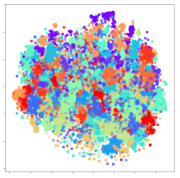 |  |  |
| Resnet-50 | 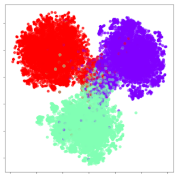 | 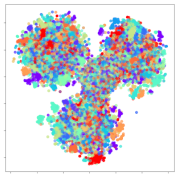 |  |  |
| VMD | 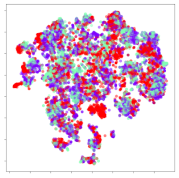 | 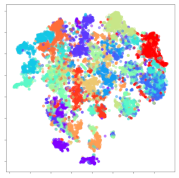 | 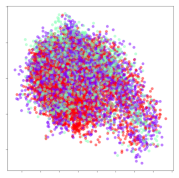 | 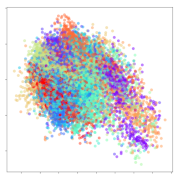 |
| MIDA | 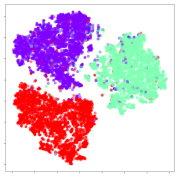 | 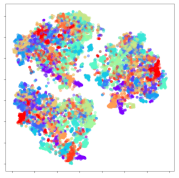 | 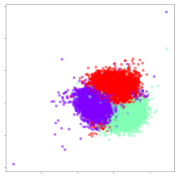 |  |
| BiVDANN |  |  | 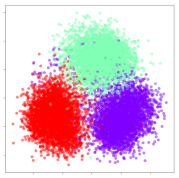 |  |
| KPCA | ||||
| Classes | Subjects | |||
 | 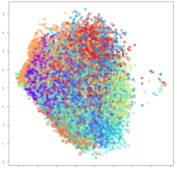 | |||
| Model | t-SNE | MDS | ||
|---|---|---|---|---|
| Classes | Subjects | Classes | Subjects | |
| CNN |  |  |  |  |
| Resnet-50 |  | 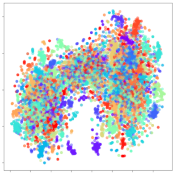 |  | 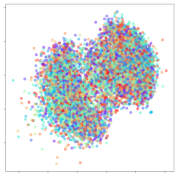 |
| VMD | 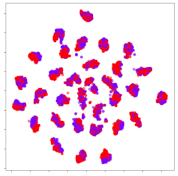 | 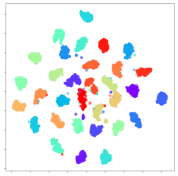 | 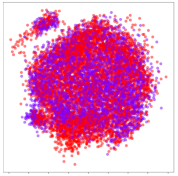 |  |
| MIDA |  |  |  | 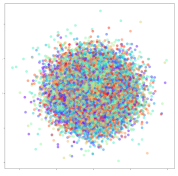 |
| BiVDANN |  |  | 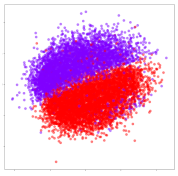 | 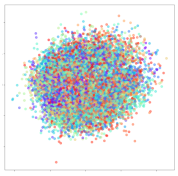 |
| KPCA | ||||
| Classes | Subjects | |||
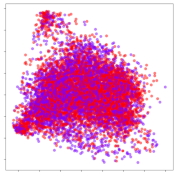 | 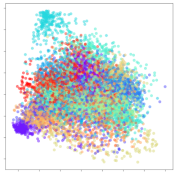 | |||
| BiCNN | BiVAE | BiDANN | L-VDANN | R-VDANN | BiVDANN | |
|---|---|---|---|---|---|---|
| Mean | 52.02% | 53.41% | 60.71% | 57.49% | 58.54% | 63.28% |
| SD | 5.29% | 3.80% | 5.33% | 6.11% | 5.66% | 6.45% |
| BiCNN | BiVAE | BiDANN | L-VDANN | R-VDANN | BiVDANN | |
|---|---|---|---|---|---|---|
| Mean | 52.15% | 58.08% | 61.59% | 60.69% | 62.10% | 63.52% |
| SD | 6.42% | 6.32% | 5.09% | 4.11% | 5.45% | 5.21% |
Publisher’s Note: MDPI stays neutral with regard to jurisdictional claims in published maps and institutional affiliations. |
© 2021 by the authors. Licensee MDPI, Basel, Switzerland. This article is an open access article distributed under the terms and conditions of the Creative Commons Attribution (CC BY) license (http://creativecommons.org/licenses/by/4.0/).
Share and Cite
Hagad, J.L.; Kimura, T.; Fukui, K.-i.; Numao, M. Learning Subject-Generalized Topographical EEG Embeddings Using Deep Variational Autoencoders and Domain-Adversarial Regularization. Sensors 2021, 21, 1792. https://doi.org/10.3390/s21051792
Hagad JL, Kimura T, Fukui K-i, Numao M. Learning Subject-Generalized Topographical EEG Embeddings Using Deep Variational Autoencoders and Domain-Adversarial Regularization. Sensors. 2021; 21(5):1792. https://doi.org/10.3390/s21051792
Chicago/Turabian StyleHagad, Juan Lorenzo, Tsukasa Kimura, Ken-ichi Fukui, and Masayuki Numao. 2021. "Learning Subject-Generalized Topographical EEG Embeddings Using Deep Variational Autoencoders and Domain-Adversarial Regularization" Sensors 21, no. 5: 1792. https://doi.org/10.3390/s21051792
APA StyleHagad, J. L., Kimura, T., Fukui, K.-i., & Numao, M. (2021). Learning Subject-Generalized Topographical EEG Embeddings Using Deep Variational Autoencoders and Domain-Adversarial Regularization. Sensors, 21(5), 1792. https://doi.org/10.3390/s21051792





